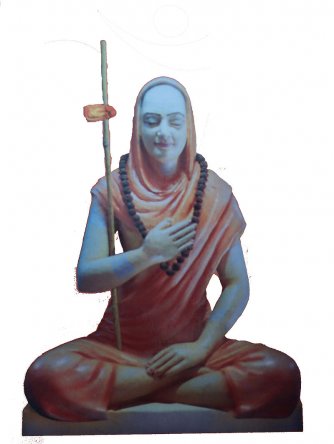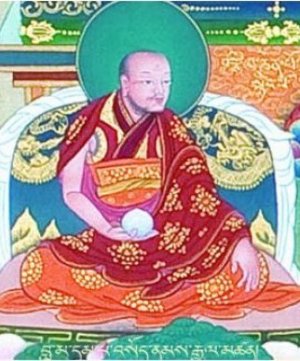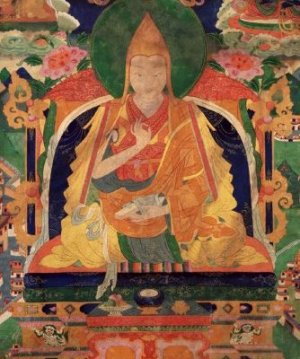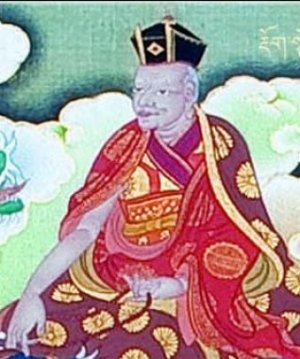| Library / Biographies |
Gauḍapāda Biography

Adi Guru Śri GauḍapādāchāryaGauḍapāda also referred as Gauḍapādācārya was the first historical teacher in the Advaita Vedānta tradition. While details of his biography are uncertain, his ideas inspired others such as Adi Śaṅkara who called him a Paramaguru (supreme teacher).
Scholars agree on fixing the lower limit of Gauḍapāda’s date around 500 A.D, based on historical, documental, literary, legendary, and other evidences to reach this conclusion. His name indicates that he was a north Indian by birth, and many places, from Kashmir to Bengal, have been postulated as his home.
Gauḍapāda was the author or compiler of the Māṇḍukya Kārikā, also known as Gauḍapāda Kārikā. The text consists of four chapters, of which Chapter Four uses Buddhist terminology thereby showing it was influenced by Buddhism.
“Gauḍapāda thus flourished after all the great Buddhist teachers Aśvaghoṣa, Nāgārjuna, Asaṅga and Vasubandhu; and I believe that there is sufficient evidence in his kārikās for thinking that he was possibly himself a Buddhist, and considered that the teachings of the Upaniṣads tallied with those of Buddha.” (S. Dasgupta)
However, the consensus among scholars of Hinduism is that doctrinally Gauḍapāda's work is Hindu, and not Buddhist. The first three chapters of Gauḍapāda's text have been influential in the Advaita Vedānta tradition. Parts of the first chapter that include the Mandukya Upanishad have been considered a valid scriptural source by the Dvaita and Vishistadvaita schools of Vedānta.
Several additional works are attributed to Gauḍapāda, but their authenticity is uncertain. The attributed works are:
• Brihadaranyaka Upaniṣad Bhāṣya;
• Nṛsimha Uttara Tāpini Upaniṣad Bhāṣya;
• Anugita Bhāṣya;
• Uttara Gita Bhāṣya.
In the Śri Vidyā tantric tradition, ascribed to Gauḍapāda are:
• Durgāsaptasati;
• Subhagodaya Stuti and
• Śri Vidyāratna Sūtra.
Śrī Sansthāna Gauḍapādācārya Maṭha (monastery), also known as Kavaḷē Maṭha, located in Kavale, Ponda, Goa, was founded by Gauḍapāda around 740 AD. The monastery follows a “Guru-Śiṣya” system in which head of the Matha appoints a śiṣya, who succeeds the guru. The śiṣya is selected at very young age. The existing head of the Math decides upon a worthy disciple, initiates him as a sannyāsin, and appoints him as the head. The current master is the 77th in the uninterrupted succession of Śrī Gauḍapādācārya Matha’s masters.
Govinda Bhagavatpāda was the disciple of Gauḍapāda and the Guru of Adi Śaṅkara. He is named after Gauḍapāda in the Guru Paramparā (lineage) of Śṛngēri Śāradā Pītham. 1
Sources:
• https://en.wikipedia.org
• Gauḍapāda, A Study in Early Advaita, T.M.P. Mahadevan
• A History of Indian Philosophy By Surendranath Dasgupta, Vol I, ch. 10.4
Footnotes
1. Dakṣināmnāya Śrī Śāradā Pītham or Sri Sringeri Mutt is one amongst the four cardinal pīthams established by the 8th century philosopher-saint Śrī Ādi Śaṅkara to preserve and propagate Sanātana Dharma and Advaita Vedānta, the doctrine of non-dualism. Located in Śringerī in Chikmagalur district in Karnataka, India, it is the Southern Āmnāya Pītham amongst the four Chaturāmnāya Pīthams, with the others being the Dvārakā Śāradā Pītham (Gujarat) in the West, Purī Govardhana Pīṭhaṃ (Odisha) in the East and Badri Jyotishpīṭhaṃ (Uttarakhand) in the North. A maṭha, also written as math, mutt, or mut, is a Sanskrit word that means 'institute or college', and it also refers to a monastery in Hinduism.





